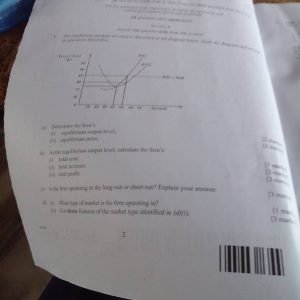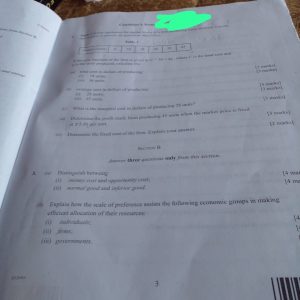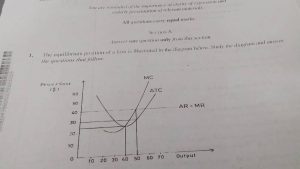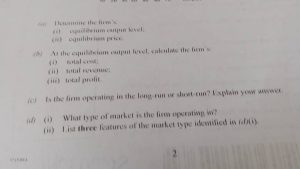Table of Contents
waec Economics questions and answers 2023
Here is the waec Economics questions and answers 2023
Questions





ANSWERS
3bi. *Individuals:*
Scale of preference assists in making efficient allocation for individuals by allowing them to rank their preferences for different goods and services. This provides a basis for making decisions on how to allocate resources. By ranking preferences, individuals can identify which goods and services they value most and allocate resources accordingly. This helps to ensure that resources are allocated in the most efficient way possible, as individuals are able to prioritize their needs and wants. Additionally, scale of preference can help individuals to make decisions about how to allocate resources over time, as they can adjust their preferences based on changing needs and wants.
(5a)
A sole proprietorship is a business model where an individual is an owner as well as the operator of the business Whereas A partnership is a business model where two or more persons agree to carry on business and share profits and losses mutually.
(5b)
(i) Sole owner of the business
(ii) Unlimited liability
(iii) No legal entity
(iv) Sole decision maker
(5c)
(i) Generation of Income through Public Issue of Shares: One of the major channels through which Public Limited Companies generate capital is y selling shares to the public.
(ii) Security for Loan Advancement: Public Limited Companies can obtain and secure loans using the assets of the company as security as opposed to using the personal assets of the members.
(iii) Spreading Risks of Ownership: Because a Public Limited Company allows for pubic and unlimited membership, the risk of ownership is then spread amongst many people as opposed to being centered on a few as in the case of a Private Limited Company.
(iv) Separate Legal Identity: A duly incorporated Public Limited Company has an identity entirely different from that of the members. This means that the company is capable of independent existence and can enter into contractual transactions, acquire and own properties, and has the legal capacity to sue and be sued in its own name.
*ANOTHER NUMBER 7*
7a. *Gross domestic product (GDP):* This is the total market value of final goods and services produced in a country at a particular period of time. In calculating the GDP of a country, no account is taken of the nationality of those that produce the goods and services.GDP is used in determining whether the country concerned is experiencing economic growth,decline or stagnation.
7b. *Output method:* The output method of measuring the gross domestic product involves summing up the market values of all output of the economy, sector by sector. Measurement is done using the value added method. Value added is defined as the value of output, less cost of input. In this method, national income is measured by adding together the value of enterprises which include individuals, firms and the government. Output method is also called net product or added value method.
7c. *Pick any three*
(1) Insufficient technical expertice:Thetechnical expertise, which is an essential element for collecting and analysing data,is insufficient.
(2) Problem of double counting: Some goods can be counted twice and this gives false national income estimates.
(3) Subsistence production:Thepredominance in the Nigerian economy of subsistence production,e.g.farming,tailoring and carpentry, makes estimation difficult.
(4) Problems of inflation: The national income figures can be over- or under-estimated as a result of inflation or deflation.
(5) Inability to quantify some services:Some services are not easily quantified,thereby affecting the national income estimates, e.g. housewives’ services.
(6) Difficulties in estimating net valuation: There are difficulties in estimating the value of net income from abroad. This is because many individuals may be involved,hence making accurate assessment impossible.
*ANOTHER NUMBER 8*
(8a)
(PICK ANY ONE)
An embargo refers to a government-imposed restriction or ban on the importation or exportation of certain goods or services to or from a particular country. It is a trade barrier that is typically implemented for political or economic reasons.
OR
An embargo can be defined as a governmental action that prohibits or restricts trade activities between countries which involves the deliberate limitation or complete prohibition of imports or exports of goods, services, or specific products to or from a targeted country.
(8b)
(PICK ANY THREE)
(i) Protecting Domestic Industries: Tariffs can be used to shield domestic industries from foreign competition by making imported goods more expensive. This protectionist measure aims to provide a competitive advantage to domestic producers, allowing them to grow and maintain employment levels.
(ii) Promoting National Security: Tariffs can be employed to safeguard industries that are considered vital for national security, such as defense or critical infrastructure. By discouraging reliance on foreign suppliers, tariffs can ensure a country’s self-sufficiency in essential goods and protect against potential disruptions in the global supply chain.
(iii) Correcting Trade Imbalances: Countries may impose tariffs to address trade imbalances, where the value of imports significantly exceeds that of exports. By making imported goods more costly, tariffs aim to reduce imports and encourage domestic production and export-oriented industries, thereby narrowing the trade deficit.
(iv) Revenue Generation: Tariffs can serve as a revenue source for governments. Import duties levied on imported goods generate income that can be used to fund public services, infrastructure projects, or reduce budget deficits.
(v) Encouraging Fair Trade Practices: Tariffs can be implemented as a response to unfair trade practices, such as dumping or subsidies provided to foreign producers. By imposing tariffs on goods that are sold below their fair market value or benefiting from government subsidies, countries can create a more level playing field for domestic industries.
(vi) Environmental Protection: Tariffs can be used to promote environmentally friendly practices by discouraging the importation of goods produced in countries with lax environmental regulations. This measure aims to prevent the outsourcing of pollution and encourage global adherence to environmental standards.
(vii) Infant Industry Protection: Tariffs can be employed to support the growth of emerging or “infant” industries in a country. By shielding them from foreign competition during their early stages, tariffs provide these industries with a chance to develop, gain competitiveness, and eventually contribute to the domestic economy.
(8c)
(PICK ANY THREE)
(i) Increased Consumer Prices: Tariffs lead to higher prices for imported goods, which can directly impact consumers. When tariffs are imposed, the cost of imported products rises, and domestic consumers may have to bear the burden of these increased prices. This can reduce consumers’ purchasing power and potentially lead to decreased overall welfare.
(ii) Retaliation and Trade Wars: Imposing tariffs can trigger retaliatory measures from other countries. When one country raises tariffs, other countries may respond by imposing their own tariffs on the original country’s exports. This can escalate into a trade war, where trade barriers increase on both sides, harming global economic growth and stability.
(iii) Reduced Efficiency and Productivity: Tariffs disrupt international supply chains and hinder the efficient allocation of resources. They can discourage the use of imported inputs, which may be more cost-effective or of higher quality than domestic alternatives. This can reduce overall productivity, increase production costs, and limit the competitiveness of domestic industries in the global market.
(iv) Negative Impact on Exporters: Tariffs can harm industries reliant on exporting their products. When a country imposes tariffs on imports, it can trigger retaliatory actions, reducing demand for the country’s exports. This can adversely affect export-oriented industries, leading to job losses, decreased revenues, and economic difficulties for those relying on international trade.
(v) Distortion of Comparative Advantage: Tariffs can distort comparative advantage, which is the principle that countries specialize in producing goods and services in which they have a relative advantage. By protecting domestic industries through tariffs, resources may be diverted from sectors where the country has a competitive edge to less efficient industries. This can hinder overall economic efficiency and limit potential gains from trade.
(vi) Consumer Choice and Innovation: Tariffs limit the variety and availability of imported goods, leading to reduced consumer choice. Domestic industries that are protected by tariffs may face less pressure to innovate and improve their products since they face less competition. This can hinder technological progress, limit market dynamism, and slow down overall economic development.
4a)
An economic system is a set of institutions, laws, and customs that determines how economic decisions are made, how goods and services are produced and distributed, and how resources are allocated in a society.
4b)
(i) Aim of production: In a capitalist economy, the aim of production is to maximize profit, while in a socialist economy, the aim of production is to meet the needs of society and ensure social welfare.
(ii) Consumer sovereignty: In a capitalist economy, consumer sovereignty is the principle that consumers determine what goods and services are produced through their purchasing decisions. In a socialist economy, the government determines what goods and services are produced based on the needs of society.
(iii) Competition: In a capitalist economy, competition is encouraged as a means of promoting innovation, efficiency, and consumer choice. In a socialist economy, competition is often discouraged or eliminated in favor of cooperation and collective ownership of the means of production.
4c)
(i) Land is a natural resource that is fixed in supply and cannot be created by human effort.
(ii) Land is heterogeneous, meaning that different parcels of land have different qualities, such as soil fertility, mineral deposits, and climate, that affect their productivity.
(iii) Land is subject to the law of diminishing returns, meaning that as more and more of the other factors of production (labor and capital) are applied to a given parcel of land, the marginal productivity of those factors will eventually decline.
*ANOTHER NUMBER 6*
(6a)
(PICK ANY ONE)
Location of industry may be defined simply as the sitting or establishment of a firm or industry in a particular place. An industry may be established either by individuals or government, either for economic or political reasons
OR
Location of industry refers to the geographical distribution or placement of industrial activities or businesses within a region or country. It focuses on understanding the factors that influence the decisions made by firms when choosing where to establish their production facilities.
(6bi)
Raw materials: Cement producing industries should be located close to sources of raw materials to reduce cost of transportation. Perishable goods like fruits, palm oil industries, etc should be located near their raw materials
(6bii)
Market: There should be ready market for the products of any industry to be sited in a place. Fragile goods like glass, bulky goods like cement and other perishable goods should be located near the market. Such industries located or directed towards the market are called market- oriented industries.
(6biii)
Government policy: Government can encourage the location of industries through certain policies like: Direct participation in setting up of industries. Creation of industrial zones in the country Provision of infrastructures like electricity, pipe-borne water, roads and tele- communications.
(6c)
(PICK ANY THREE)
(i)It encourages development: The growth of industries leads to an increase in production of goods and services.
(ii)Emergence of subsidiary firms: As major firms concentrate in one area, other subsidiary service firms that assist those major firms in the production of goods usually emerge.
(iii)Generation of employment: The concentration of many industries in an area leads to the creation of many job opportunities.
(iv)Emergence of organised market: Localisation of industries assists in the emergence of organised market for the products.
(v) Creation of competition: The existence of many industries leads to a healthy competition among them in order to excel or outsell one another.
(vi) Attraction of more people: A highly concentrated industries estates attracts different shades of people to such area for one reason or the other.
